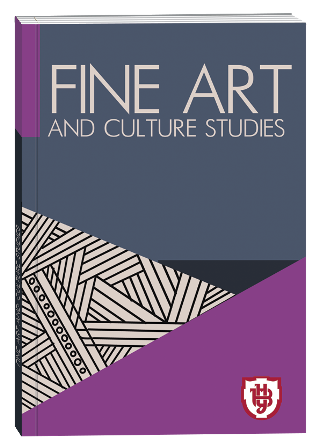AESTHETIC BASIS OF LANDSCAPENESS IN CHINESE MUSIC ART
DOI:
https://doi.org/10.32782/facs-2023-3-4Keywords:
landscape, nature, painting, poetry, music, aesthetic concept, image.Abstract
The article deals with ways of landscape figurativeness formation in music art of China. Origination of landscapeness in national painting and poetry is retraced. The objective of the study is to find aesthetic basis of landscape figurativeness formation in music art of China. Methodology of the study is complex, in particular, such methods are used: comparative analysis, which helps to find peculiarities of landscape thinking formation in different kinds of Chinese art; philosophical aesthetical one, applied while investigation of certain aesthetic concepts and philosophic judgements; historical culturological one – helps to find genesis and evolution of definite cultural phenomena; analysis and synthesis – aimed to generalise obtained results, to form grounded and logical conclusions. Scientific novelty of the article consists in revealing aesthetic basis of landscape thinking of the Chinese, which is observed in all kinds of artistry. It is emphasized in the article, that development of Chinese music art is connected with aesthetic concepts and a circle of images, formed by national traditions and mentality. Nature is one of the most popular motifs in Chinese art. Artist`s process of creation is integration with nature, confluence with the world and representation of this beauty in works of art. General aesthetic principle is «landscapeness», which has profound philosophical sense, connected with three basic world-viewing doctrines. Landscapeness of thinking is characteristic to all kinds of artistry of the Celestial Empire: painting, poetry and music. It can be seen in common figurative symbolism; special emotionality directed to aesthetics of feelings; impressionistic writing, which unites objects into a veil of half-tints and ambiguity of unsaid. The images of the sky, mountains, water, birds, animals and plants make up a basis of Chinese landscapeness. The language of these natural symbols often reflects the state of human soul, as absolute connection with surrounding world, which is the utmost ideal in the national aesthetics, is a basis of mentality of the Celestial Empire inhabitants. In conclusion it is summarized, that landscape aesthetics is highly implemented in Chinese music art, figurative palette and system of artistic devices of which are aimed to represent sensible perception of reality. Chinese music art investigation is prospective. Investigation of the music of the Celestial Empire makes one plunge into unique world of eastern cultures, find spiritual guidelines, which formed the system of images and genres of national art.
References
Бай Є. Китайська фортепіанна музика в контексті інтеграційних процесів світового музичного мистецтва : автореф. дис. ... канд. мистецтвознавства :17.00.03. Харків, 2014. 18 с.
Лу Цзє. Концептосфери китайської програмної фортепіанної музики ХХ – початку ХХІ ст. : дис. ... канд. мистецтвознавства : 17.00.03. Львів, 2017. 186 с.
Лю І. Образ рідного краю в камерно-вокальній творчості китайських композиторів. Проблеми взаємодії мистецтва, педагогіки та теорії і практики освіти, 2017. Вип. 46. С. 233–246.
Лянь Юнь. Пекінська опера як музично-естетичний феномен : автореф. дис. ... канд. мистецтвознавства : 17.00.03. Харків, 2009. 18 с.
Лянь Юнь. Порівняльний аналіз пекінської та італійської опер. Проблеми взаємодії мистецтва, педагогіки та теорії і практики освіти, 2008. Вип. 21. С. 156–165.
Сергієнко Т. Китайська цивілізація: традиції та сучасність : матеріали ХVІ міжнародної наукової конференції, 30 листопада 2022 р. Київ–Львів–Торунь : Liha-Pres. С. 133–135.
Ту Дуня. Паралелі художнього розвитку оперного театру Європи та Китаю: автореф. дис. ... канд. мистецтвознавства : 17.00.03. Одеса, 2010. 16 с.
Хуан Чжулін. Шляхи розвитку дитячої фортепіанної музики в Китаї : автореф. дис. ... канд. мистецтвознавства : 17.00.03. Харків, 2009. 18 с.
Цао Хе. Вокальна спадщина Шан Деї: синтез національних та європейських традицій : автореф. дис. ... канд. мистецтвознавства : 17.00.03. Суми, 2019. 20 с.
Цинь Тянь. Образ рідного краю у фортепіанних творах китайських композиторів : автореф. дис. ... канд. мистецтвознавства : 17.00.03. Харків, 2012. 18 с.
Чень Жуаньсюань. Імпресіонізм в фортепіанній музиці китайських композиторів : автореф. дис. ... канд. мистецтвознавства : 17.00.03. Харків, 2014. 19 с.
Fang Xiao. Philosophical reflections on the technique of Chinese painting, art and Tao. Hunan Normal University, 2018. 276 p.
Guangzhun L. & Suhua H. Discussion on Russian and Chinese Language, Culture and Customs. Beijing, 1999. 231 р.
Shaughnessy Edward. The Writing of the Xici Zhuan an the Making of the Yijing. URL :https://www.biroco.com/ yijing/Shaughnessy_Xicizhuan.pdf. (дата звернення: 04.07.2023).
Spengle O. Der Untergang des Abendlande. München :Beck, 1998. 1287 p.







